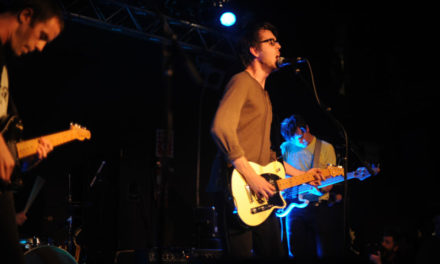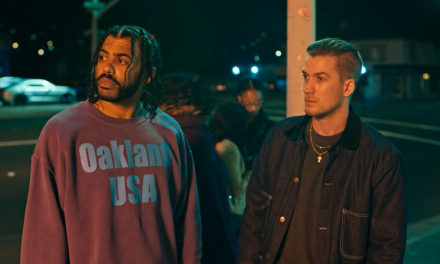People often say that good things come in threes, and Foster the People’s engrossing albums are no exception.
The band’s first album, “Torches,” is seemingly perfect, and its second album,“Supermodel,” is the underappreciated, often forgotten middle child who deserves more attention. And this past summer Foster the People sprang forth their third album, “Sacred Hearts Club,” a distinguished addition to a collection of thoughtful, diverse music.
Foster the People’s national tour is popularizing the dynamic, powerful songs of “Sacred Hearts Club.” A stop at the Tabernacle Sept. 30 gave Atlanta the chance to reacquaint itself with the alternative pop band and to hear how it has evolved.
The integration of all three albums into one evening made for spectacular variety; the alternative style of each album makes it difficult to pinpoint what is typical of Foster the People. Lead singer Mark Foster and his fellow band members craft albums like a collection of vignettes; the songs on each album are interwoven with similar themes, but each album is clearly independent of the others. “Sacred Hearts Club” is most distinguished by its elements of hip-hop, rap and psychedelic music. With the exception of percussionist Mark Pontius, bandmates, Sean Cimino and Issom Innis, and touring members Phil Danyew and Tyler Halford, often rotate their roles on keyboard, guitar, percussion and synthesizers. Foster is the primary songwriter, though the entire band contributes to the songs.
During the Tabernacle performance, Foster’s stage presence was captivating. Sporting a black leather jacket and 1950s gelled hair, he was reminiscent of John Travolta in “Grease.” His attitude was the perfect mixture of confidence and genuine excitement. While Foster didn’t interact with the audience as much as some performers do, it was refreshing not to hear “I always love coming to Atlanta” and “You guys are the best” prior to each song. Instead, he often closed his eyes and motioned his hands along to the lyrics. Although eye contact is usually important when connecting to a crowd, in those moments, it felt like the audience was bearing witness to his deepest emotions. He seemed comfortable enough to invite audience members into his personal space and reveal his true musicianship.
The band’s chemistry and years of experience shined through its ability to spread happiness — when the artists let loose on stage in their movements, the audience, too, gained energy. As the set progressed, there were longer pauses between songs, but the band maintained the crowd’s attention by playing sustained chords on guitars and creating atypical sounds with synthesizers. The pauses also kept the audience guessing which song Foster the People would play next. To build suspense, one of the members gave a telling smile and played a few notes slowly on the keyboard, making it easy to identify the song “Life on the Nickel” from the album “Torches.” As the crowd roared, he repeated the notes in time and the song continued.
In one of the most memorable moments of the evening, Foster improvised a section of “Houdini.” He conducted an instrumental interlude commenced with the two drummers pounding out intricate beats. Foster turned toward them with his back to the audience, but sustained high energy in his movement to the rhythm. His minimal, sporadic gestures suggested dynamics and style to his bandmates while still leaving freedom for self-expression in their execution. The other musicians accompanied the percussionist on guitar and keyboard until Foster returned to the microphone, and they finished the song together.
Though my memories of the concert are joyful the songs from “Sacred Hearts Club” are young and have room to grow when performed. Compared to those of its older siblings, the execution of the songs’ pitches and new style was not as seamless. Time will likely lead the band to greater comfort in sharing their new songs in a live setting. More importantly, the entire set was exciting, and the intense emotions conveyed through the music overpowered the technical imperfections.
“Sacred Hearts Club” proves that Foster the People’s genius extends beyond one genre. Some fans dislike the album because it differs in style from their previous material, but some are drawn to the band’s musical development. Different modes of expression indicate that a group can stay true to its art while being unrestrained by the expectations of listeners. One should anticipate that the next album will have an identity unlike the others.
Toward the end of the night, Foster spoke about how politics influenced “Sacred Hearts Club,” acknowledging discrimination against Muslims and the rise of nationalism. Divisive issues have caused fear and isolation, but Foster rejects this nature of separation. Instead, he chooses unity.
Foster said that working on “Sacred Hearts Club” over the past three years helped him cope in the face of tragedies, including the Syrian Civil War, that happened around the world. His message that “love is the only answer” is embedded in his songs. Lines like, “The deaf man heard what the mute man said / Then they all followed where the blind man led” from “Pay The Man” suggest trust and collaboration.
Music is the most unifying thing, Foster said. Whether someone is black, white or brown, whether Christian, Jewish or Muslim, born male or female, gay or straight, grew up with a little money or a lot of money, he said, that’s what make people who they are.
“And I love you,” Foster finished. “Love is bigger than politics, and it always will be.”
As Foster the People branches out into new styles, listeners can rely on the band’s dedication to creating meaningful songs. The impressive live show confirmed how some audience members, like myself, envision the group when listening to recordings: passionate musicians excited to share their talent with the people.





